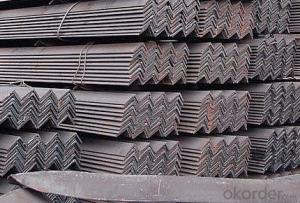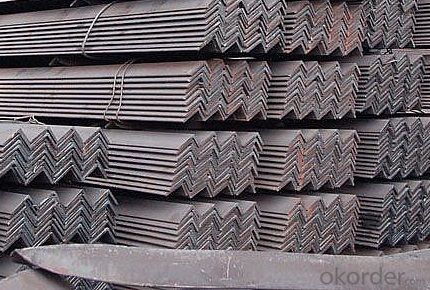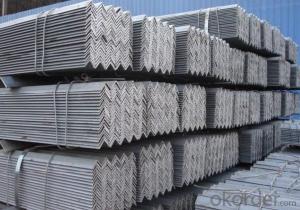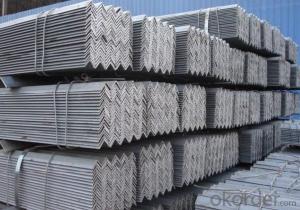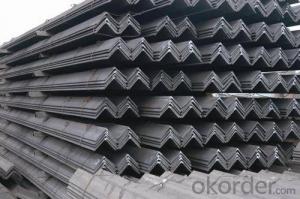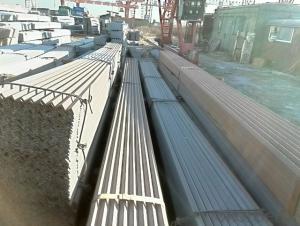High Qualiy Steel Angle
- Loading Port:
- China Main Port
- Payment Terms:
- TT OR LC
- Min Order Qty:
- -
- Supply Capability:
- -
OKorder Service Pledge
Quality Product, Order Online Tracking, Timely Delivery
OKorder Financial Service
Credit Rating, Credit Services, Credit Purchasing
You Might Also Like
Quick Details
Standard:AISI, ASTM, BS, DIN, GB, JIS
Dimensions:20x3----200x24
Grade:Q195-Q420 Series
Model Number:Q235, Q345
Type:Equal
Application:construction
product name:standard angle steel
Standard:ASTM,BS,DIN,GB,JIS
Grade:SS400-SS540 Series
Model Number:Q235, Q345
Application:construction
origion:China
packing:bundle
length:6m 9m 12m
Type:Carbon Structural Steel
Packaging & Delivery
Packaging Details: standard export packing,packed in bundles,suitable sea transport Delivery Detail: 10-15 days after received the payment advance
- Q: Are steel angles suitable for manufacturing support brackets for cables?
- Yes, steel angles are suitable for manufacturing support brackets for cables. Steel angles provide strength and durability, making them an ideal choice for supporting and securing cables in various applications. They offer stability and can be easily customized and fabricated to meet specific requirements, ensuring reliable support for cable systems.
- Q: Are steel angles suitable for manufacturing shelving units?
- Yes, steel angles are highly suitable for manufacturing shelving units due to their strength, durability, and versatility. Steel angles provide excellent support and stability, making them ideal for supporting heavy loads and maximizing storage space. Additionally, their rigid structure allows for easy customization and installation, making them a popular choice in the manufacturing of shelving units.
- Q: What is 4# angle iron? What are the classifications of angle iron? What are the specifications? Thank you
- 4# angle steel refers to both sides are 4 cm wide, the thickness of 4 mm angle iron.Angle steel has national standard, that is, the width of both sides is equal, the thickness is width 1/10, the length is usually 6 meters.
- Q: Can steel angles be used for pipe support systems?
- Indeed, pipe support systems can indeed utilize steel angles. In construction and engineering ventures, steel angles are frequently employed due to their exceptional durability, stability, and adaptability. When employed as pipe supports, steel angles furnish a robust and dependable framework for securely holding pipes in position. They can effortlessly be joined through welding or bolting to other structural elements, rendering them suitable for a variety of pipe support applications. Furthermore, steel angles can be fabricated and tailored to satisfy specific requirements, encompassing diverse pipe sizes and load-bearing capacities. In summary, owing to their resilience and capacity to withstand substantial loads, steel angles remain a favored option for pipe support systems.
- Q: What are the different grades of steel used for manufacturing steel angles?
- The different grades of steel used for manufacturing steel angles include A36, A572, A588, and A992.
- Q: What is the thickness of the national standard 8# angle steel? Thank you
- The angle iron can be made up of different force components according to the different structure, and can also be used as the connecting piece between the components. Widely used in a variety of architectural and engineering structures, such as beams, bridges, towers, hoisting and conveying machinery, ships, industrial furnace, reaction tower, container frame and warehouse.
- Q: What are the different methods of surface preparation for steel angles?
- There are several methods of surface preparation for steel angles in order to ensure proper adhesion of coatings, improve corrosion resistance, and enhance the overall durability of the material. Some of the common methods include: 1. Mechanical Cleaning: This involves using mechanical tools such as wire brushes, sandpaper, or abrasive discs to physically remove dirt, rust, mill scale, and other contaminants from the surface of the steel angles. This method is relatively simple and cost-effective but may not be suitable for heavy corrosion or stubborn deposits. 2. Chemical Cleaning: Chemical cleaning involves the use of acid-based solutions or pickling pastes to dissolve rust, scale, and other contaminants. The solution is applied to the surface and left for a specific period before being rinsed off. This method is highly effective in removing stubborn deposits but requires careful handling and proper disposal of the chemicals. 3. Power Tool Cleaning: Power tool cleaning utilizes power tools like grinders, sanders, or needle guns with abrasive attachments to remove rust, scale, and other contaminants. This method is faster and more efficient than manual mechanical cleaning, making it suitable for large-scale surface preparation. 4. Blast Cleaning: Blast cleaning, also known as abrasive blasting, involves propelling abrasive materials (such as sand, steel grit, or glass beads) at high velocity onto the steel surface using compressed air or centrifugal force. This method effectively removes rust, scale, and other contaminants, providing a clean and profiled surface. It is widely used in industrial applications but requires proper safety measures to protect workers from exposure to abrasive materials. 5. Flame Cleaning: Flame cleaning is a method where a high-temperature flame is directed onto the steel surface to remove contaminants. The intense heat burns off organic materials and evaporates moisture, leaving a clean surface. This method is particularly useful for removing oil, grease, and paint residues. 6. Conversion Coating: Conversion coating involves applying a chemical solution onto the steel surface, which reacts with the metal to form a thin protective layer. This layer enhances the adhesion of subsequent coatings and provides additional corrosion resistance. Common conversion coatings include phosphating, chromating, and passivation. It is important to note that the selection of the most appropriate surface preparation method depends on factors such as the extent of corrosion, the desired coating system, and the environmental conditions the steel angles will be exposed to. Consulting with experts or referring to industry standards can help determine the most suitable method for a specific application.
- Q: Can steel angles be used in window frames?
- Yes, steel angles can be used in window frames. Steel angles are commonly used in construction and can provide structural support and stability to window frames. They are often used as reinforcements or brackets to connect the window frame to the wall or to other components of the window system. Steel angles are durable, strong, and resistant to corrosion, making them a suitable choice for window frame construction. Additionally, steel angles can be easily customized and fabricated to fit different window sizes and designs.
- Q: Are steel angles easy to install?
- Installing steel angles can be a relatively straightforward task, depending on the specific use and the expertise level. These angles are commonly employed in construction projects for structural support, reinforcement, and framing purposes. The installation procedure generally entails measuring, cutting, and securing the steel angles in the desired location using appropriate fasteners like screws, bolts, or welding. Nevertheless, it's worth noting that the ease of installation may vary depending on the project's complexity and the skills possessed by the individual or team carrying out the installation. Those with professional experience or expertise may find it easier to install steel angles due to their familiarity with the materials and techniques involved. Conversely, those lacking experience may require guidance or assistance from professionals to ensure proper installation and adherence to safety guidelines. In summary, with the correct tools, knowledge, and precautions, steel angles can be relatively easy to install. It is always advisable to follow the manufacturer's instructions, seek professional advice when necessary, and prioritize safety to achieve optimal results during the installation process.
- Q: Can steel angles be used as supports for mechanical or electrical equipment?
- Yes, steel angles can be used as supports for mechanical or electrical equipment. Steel angles are versatile and strong, making them suitable for a wide range of applications. They can provide stability, rigidity, and support to hold mechanical or electrical equipment in place. The L-shaped design of steel angles allows for easy attachment and installation, making them convenient for various mounting needs. Additionally, steel angles can be easily customized and fabricated to meet specific requirements, ensuring a secure and reliable support system for the equipment.
Send your message to us
High Qualiy Steel Angle
- Loading Port:
- China Main Port
- Payment Terms:
- TT OR LC
- Min Order Qty:
- -
- Supply Capability:
- -
OKorder Service Pledge
Quality Product, Order Online Tracking, Timely Delivery
OKorder Financial Service
Credit Rating, Credit Services, Credit Purchasing
Similar products
Hot products
Hot Searches
Related keywords
